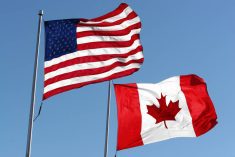Despite the wild ride canola has had during the week ended Nov. 4, it’s still ahead of where the January and March contracts had been on Oct. 28. The January had a net gain of $23.40 per tonne at $978.70/tonne, with the March up $19 at $955.30.
During that ride canola exhibited a measure of independent strength from the Chicago soy complex, which the Canadian oilseed most often follows. Continuing issues with tight supplies, strong demand despite price rationing, and concerns about the drought on the Prairies extending into next spring combined to push canola prices higher.
Read Also

Maizex Seeds to launch hybrid canola varieties for Western Canada
Maizex Seeds, an eastern Canadian seed company, will break into Western Canada with two canola hybrid varieties starting this fall.
However, canola’s increases were not entirely about a show of independence. There was support from sharp upticks in European rapeseed as well, plus gains in Malaysian palm oil. Also rising global crude oil prices supported all edible oils, as biofuels saw prices go up as well.
As is the obvious case, no rally lasts forever and this one for canola clearly had its end on Nov. 4. The January contract fell back $12/tonne and the March was down $7.80. The day before the two contracts spent a good part of the session lower, but found strength towards the end to finish with small declines.
That said, there’s still talk in the trade that canola can still push higher, perhaps breaking through $1,000/tonne, just as the November contract did before trading pretty much wrapped up for it. Right now with declines in Chicago, particularly with soyoil slipping under 60 U.S. cents per pound, the needed support for such a hike in canola just ain’t there — at least not now.
Added to that are cracks showing up in other markets such as iron ore, steel, and copper. Should these begin to pull back then pressure could extend into the oilseed market, keeping canola down.
A lot depends on the ‘king of commodities’ crude oil. With West Texas Intermediate and Brent crudes well surpassing US$80 per barrel there were happy times for edible oils. Global crude production was at the heart of the increase, with the OPEC+ alliance determined to keep to its somewhat modest production increase of 400,000 barrels per day come December.
The United States has been feeling the pinch, with energy prices spiking and inflation becoming an issue. President Joe Biden demanded OPEC+ boost production by 600,000 to 800,000 BPD, despite the U.S. having ample ability to ramp up its own production to bring global prices down. In response the cartel and its partners said no to Biden, and benchmark crude tumbled.
Canola is at a point where it could jump higher, going above $1,000, or drop lower to $950.



















